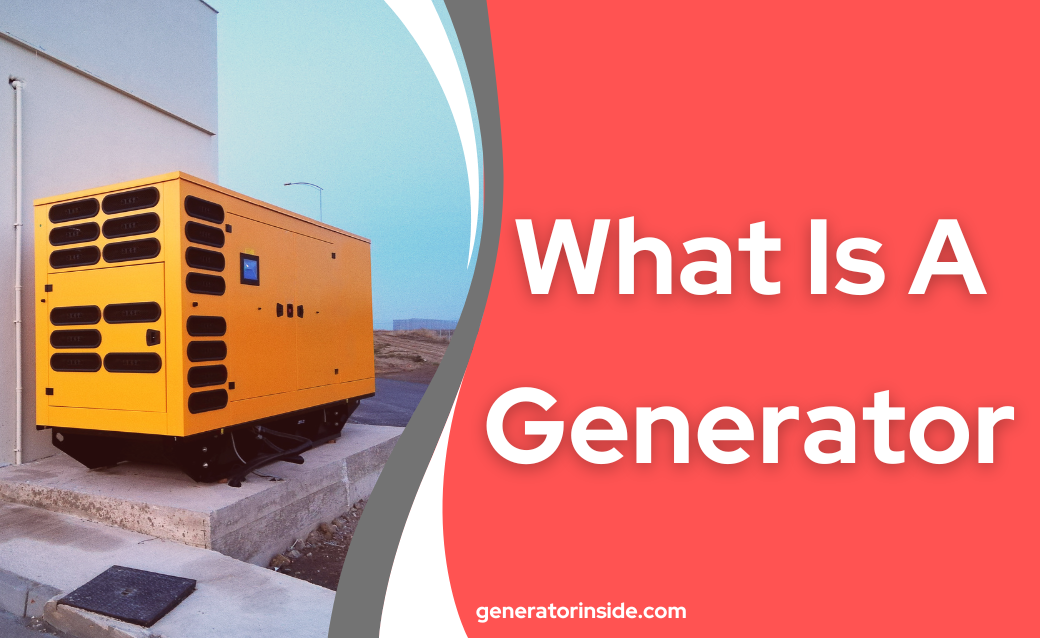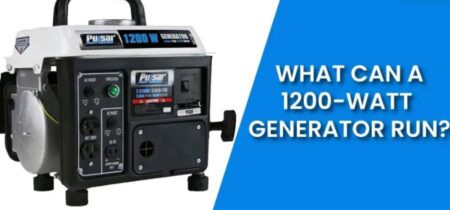
It is a critical piece of equipment in modern society, providing a reliable and stable source of power for a wide range of applications. In this blog, we will explore what a generator is, its parts, how it works, the various types of generators available, their uses and much more.
What is a Generator?
A generator is an electromechanical device that converts mechanical energy into electrical energy. It works on the principle of electromagnetic induction, which was discovered by Michael Faraday in the early 19th century. A generator typically consists of two main components: a rotor and a stator.
The rotor is a rotating component that is driven by a mechanical source such as a turbine, an engine, or a crankshaft. It is typically made up of a shaft with a magnetic field. As the rotor rotates, it creates a magnetic field that passes through the coils of wire in the stator.
The stator is a stationary component that is typically made up of a set of coils of wire, which are arranged in a specific pattern around the rotor. When the magnetic field created by the rotor passes through the coils of wire in the stator, it induces an electric current in the wire. This current flows through the wire and is transferred to an external circuit, where it can be used to power electrical devices.
Parts of a generator:
It consists of several essential parts, each of which plays a crucial role in the generator’s operation. In this article, we will discuss the various parts of a generator and their functions.
Rotor:
The rotor is a rotating component of the generator that contains a magnetic field. It is usually made up of a shaft and an iron core with copper wire winding. When the rotor rotates, the magnetic field induces an electrical current in the stator winding.
Stator:
The stator is the stationary component of the generator. It is made up of a core, which is laminated to reduce eddy current losses, and copper wire windings. The stator’s windings are positioned around the rotor, and when the rotor rotates, the magnetic field induces an electrical current in the stator windings.
Exciter:
The exciter is a small generator that provides the initial electrical current to the rotor’s windings. The exciter is usually mounted on the same shaft as the rotor and can be either a DC or AC generator.
Bearings:
The bearings are the mechanical components that support the rotor and shaft. They allow the rotor to rotate freely and are essential to the generator’s operation. The bearings are typically lubricated with oil or grease to reduce friction and prevent wear.
Prime Mover:
The prime mover is the mechanical device that provides the energy to drive the generator. It can be either an internal combustion engine or a turbine, depending on the generator’s size and application.
Governor:
The governor is a device that controls the prime mover’s speed. It maintains a constant speed to ensure that the generator produces a stable and consistent output voltage.
Voltage Regulator:
The voltage regulator is a device that regulates the output voltage of the generator. It maintains a constant voltage by adjusting the exciter’s field current.
Circuit Breaker:
The circuit breaker is a safety device that protects the generator and connected electrical equipment from damage due to electrical faults. It automatically trips when an electrical fault occurs, interrupting the flow of current and protecting the system from damage.
Control Panel:
The control panel is the interface between the generator and the operator. It contains the switches, gauges, and meters required to start, monitor, and control the generator’s operation.
Cooling System:
The cooling system is essential to keep the generator’s temperature within safe limits. The generator produces heat due to electrical and mechanical losses, and the cooling system helps dissipate that heat to maintain safe operating temperatures.
Fuel System:
The fuel system is responsible for providing fuel to the prime mover. It consists of a fuel tank, fuel pump, and fuel filters. The fuel system must be designed to meet the generator’s fuel requirements and ensure that the prime mover operates reliably.
How Does a Generator Work?
A generator works by converting mechanical energy into electrical energy through the process of electromagnetic induction. This process involves the use of a magnetic field to create an electric current in a wire.
The generator typically consists of two main components: a rotor and a stator. The rotor is a rotating component that is driven by a mechanical source such as a turbine, an engine, or a crankshaft. It is typically made up of a shaft with a magnetic field. As the rotor rotates, it creates a magnetic field that passes through the coils of wire in the stator.
The stator is a stationary component that is typically made up of a set of coils of wire, which are arranged in a specific pattern around the rotor. When the magnetic field created by the rotor passes through the coils of wire in the stator, it induces an electric current in the wire. This current flows through the wire and is transferred to an external circuit, where it can be used to power electrical devices.
The strength of the current generated by the generator depends on several factors, including the speed of the rotor, the number of coils in the stator, and the strength of the magnetic field. The voltage and frequency of the generated electricity can also be adjusted by changing the number of coils in the stator and the speed of the rotor.
What type of fuel is required by electric generators?
The type of fuel required by electric generators depends on the type of generator being used.
In general, there are two types of generators: those that run on fossil fuels and those that run on renewable energy sources. Generators that run on fossil fuels, such as diesel or natural gas, require a steady supply of fuel to operate. These types of generators are commonly used in areas where there is no access to the power grid or during emergencies when power is lost.
On the other hand, generators that run on renewable energy sources, such as solar or wind power, do not require fuel to operate. Instead, they rely on the natural energy from the sun or wind to generate electricity. These types of generators are becoming increasingly popular as people seek to reduce their dependence on fossil fuels and move towards more sustainable sources of energy.
Therefore, the type of fuel required by electric generators depends on the type of generator being used. Fossil fuel generators require a steady supply of diesel or natural gas, while generators that run on renewable energy sources do not require any fuel at all. With the increasing demand for sustainable sources of energy, the use of renewable energy generators is likely to continue to grow in popularity.
What is the process for determining the appropriate size for a generator?
Determining the appropriate size for a generator is essential to ensure that it can provide sufficient power to meet your needs. The process for sizing a generator involves several factors, including the power output required, the type of fuel available, and the electrical load of the appliances or devices that will be powered by the generator.
The first step in sizing a generator is to determine the amount of power required. This can be done by making a list of all the appliances and devices that will need to be powered by the generator and calculating their power consumption. You can find this information on the labels of the appliances or in the owner’s manual.
The next step is to determine the type of fuel that will be used to power the generator. Generators can run on a variety of fuels, including diesel, natural gas, propane, and gasoline. The type of fuel available will impact the size and type of generator that is appropriate for your needs.
Once you have determined the power requirements and the type of fuel, the next step is to calculate the electrical load. The electrical load is the amount of power that is needed to run all the appliances and devices at the same time. To calculate the electrical load, add up the wattage of all the devices that will be powered by the generator.
Finally, choose a generator that can meet your power requirements, is fueled by the available fuel type, and has a sufficient capacity to handle the electrical load. It is important to choose a generator with a capacity that exceeds your needs to avoid overloading the generator and causing damage.
In summary, sizing a generator involves determining the power requirements, type of fuel available, and electrical load of the appliances and devices that will be powered by the generator. By following these steps, you can choose a generator that meets your needs and provides reliable power in times of need.
Maintenance of a generator:
Proper maintenance of a generator is essential to ensure that it operates reliably and efficiently. Neglecting maintenance can lead to breakdowns, reduced efficiency, and even safety hazards. Here are some tips for maintaining your generator:
Regular Inspections:
Performing regular inspections is the best way to catch any potential problems before they become major issues. Check the generator’s oil level, fuel level, and battery condition at least once a month, or as recommended by the manufacturer.
Change the Oil and Filters:
The generator’s oil should be changed regularly, typically after every 100-200 hours of operation. It’s also important to change the oil filter and air filter at the same time to ensure that the generator is running at peak efficiency.
Keep it Clean:
Keeping the generator clean is important to prevent the buildup of dirt and debris, which can reduce the efficiency of the cooling system. Use a soft-bristled brush or compressed air to clean the generator’s exterior and remove any debris from the cooling fins.
Test the Battery:
The battery is an essential component of the generator’s starting system. Testing the battery regularly ensures that it has enough charge to start the generator when needed. If the battery is weak or damaged, it should be replaced.
Run it Regularly:
Running the generator regularly, even if it’s not needed, is an essential part of maintenance. This helps prevent the buildup of moisture and deposits in the engine and keeps the fuel fresh. It’s also a good idea to run the generator under load to ensure that it’s operating at its full capacity.
Hire a Professional:
For more complex maintenance tasks or repairs, it’s best to hire a professional. A certified technician can perform a full inspection and service, ensuring that the generator is in top condition.
Uses of Generators:
Generators have a wide range of uses in various industries and settings. Some of the most common applications of generators are discussed below:
Residential and Commercial Backup Power:
One of the most common uses of generators is to provide backup power in residential and commercial settings. During a power outage, a generator can keep essential electrical devices and appliances running, such as lights, heating and cooling systems, and medical equipment.
Industrial Applications:
Generators are also commonly used in industrial settings to provide power for machinery and equipment. In some cases, generators are used as the primary source of power for an entire facility. This is particularly true for remote locations where access to the electrical grid is limited or non-existent.
Construction Sites:
Construction sites require a reliable and stable source of power to keep equipment and machinery running. Generators are commonly used in construction sites to power tools, lighting, and other essential equipment.
Mining Operations:
Mining operations often take place in remote locations where there is no access to the electrical grid. Generators are used to provide power for equipment, lighting, and ventilation systems.
Healthcare Facilities:
Healthcare facilities require uninterrupted power to ensure the safety and wellbeing of patients. Generators are commonly used in hospitals and clinics to provide backup power in the event of a power outage.
Types of Generators:
There are several different types of generators available, each with its own unique characteristics and applications. Some of the most common types of generators are discussed below:
Portable Generators:
Portable generators are designed to be easily transported to different locations. They are typically powered by gasoline or propane and are commonly used for recreational activities such as camping or tailgating. Portable generators are also used as backup power sources for residential and commercial settings.
Inverter Generators:
Inverter generators are a type of portable generator that provides clean and stable power. They are often used for sensitive electronic devices such as laptops, smartphones, and medical equipment. Inverter generators are also commonly used for outdoor activities such as camping and RVing.
Standby Generators:
Standby generators are designed to provide backup power to homes and businesses in the event of a power outage. They are typically connected to the electrical grid and automatically switch on when the power goes out. Standby generators are commonly used in residential and commercial settings, as well as in healthcare facilities.
Diesel Generators:
Diesel generators are a type of generator that is commonly used in industrial settings. They are typically larger and more powerful than other types of generators and are often used to provide power to entire facilities. Diesel generators are also commonly used in remote locations where access to the electrical grid is limited.
Natural Gas Generators:
Natural gas generators are a type of generator that is powered by natural gas. They are often used in residential and commercial settings as a backup power source. Natural gas generators are cleaner and more environmentally friendly than other types of generators.
What is a Generator Conclusion:
Generators play a critical role in modern society by providing a reliable and stable source of power for a wide range of applications. From providing backup power to residential and commercial settings to powering machinery and equipment in industrial settings, generators have a wide range of uses. The different types of generators available ensure that there is a generator to meet the unique needs of each industry and setting.
Also Read:








